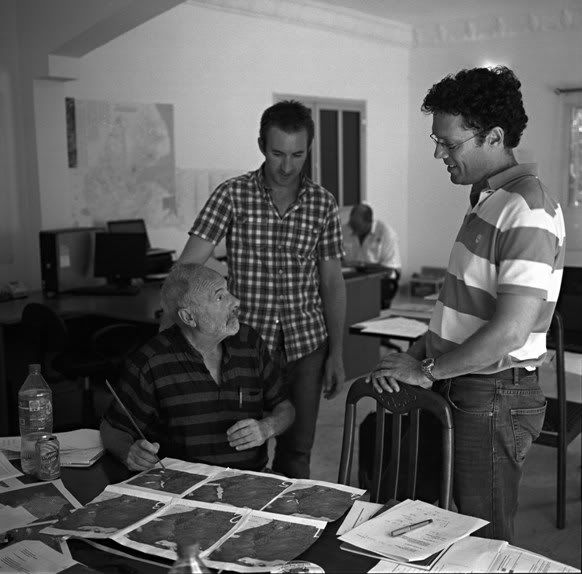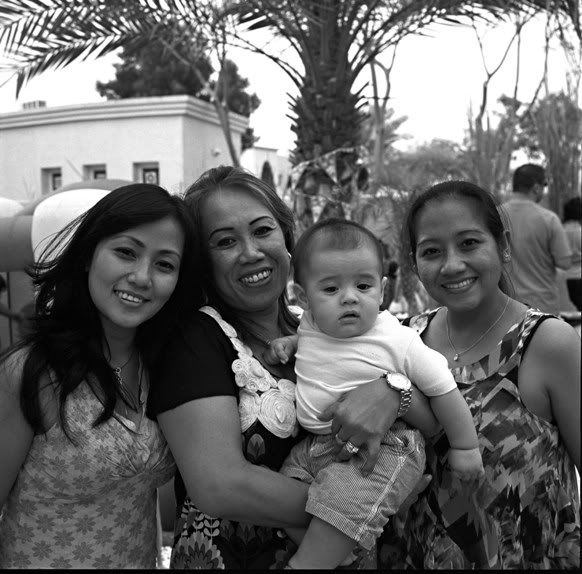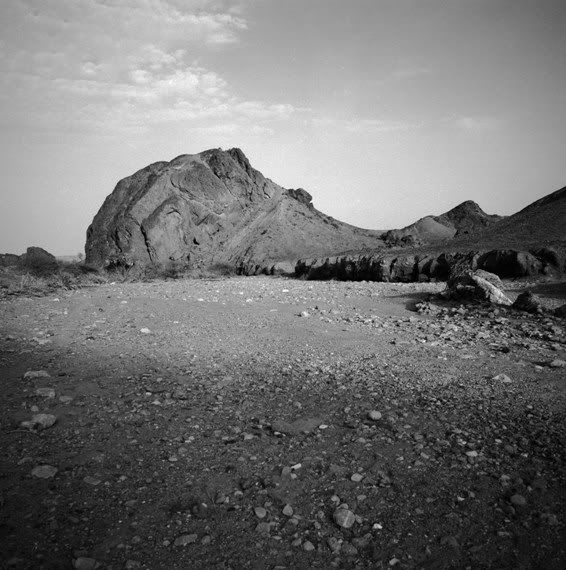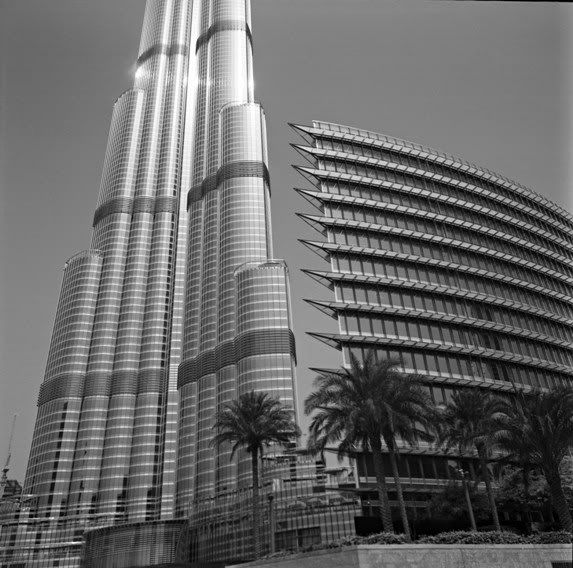swifty63
Fiat lux
Well, I got back into MF last year, then started developing my B&W at home six months ago (after one lab scratched some of my film!). I studied how to get started on the Ilford website, and of course picked up a lot from browsing this wonderful forum! It really is dead easy to develop film - but getting it exactly right will be a never-ending lifetime pursuit I think!
So here in Dubai there is only one place that sells chemicals (that's Salam at Wafi if your local and didn't know), just Ilfosol 3, so that's what I started with. Then I brought some ID-11 back from Australia and have used that most of the time.
Advice was to stick to one developer and film type, but I have tried with a variety of films - mostly Delta 100 (Salam sells it - 4x5 as well!) and Tri-X, and little bits of Pan F+ and Acros 100. I am sticking to a combination of Delta 100 and Tri-X now.
I never realised how different these films are. First time I developed Tri-X I wasn't impressed with the results (fool that I am!), but the second time I fell in love with the tones. I find it great for portraits (of which see below), but lately I've taken city-scapes around Dubai in Tri-X that came out to my satisfaction too. Delta 100 is nice and sharp, I like it for landscapes. Only, I take photo's where I work in the Ethiopian desert, very bright and contrasty, I used an orange filter last time which meant quite slow exposure times, it's just on the hand-held limit for me. (I know - use a tripod...:bang .
.
My work flow is develop then scan and tweak in PS. I want to print in a wet room, but that's not possible where I am now. Eventually - that's my next step.
Some mistakes made along the way, but hey, how else to learn?
For example, I've tried to keep my process consistent. When I developed Acros, I used the Ilford agitation method, not that recommended on the Acros infosheet. Result? Really dense negatives - I should read the instructions more carefully. And the time I put the photo-flow in first, instead of the developer. I could see from the results why Ilford recommend not to do a pre-wash with their film. Yeah, everyone makes silly mistakes I'm sure.
But for anyone considering doing their own development, I would urge you to do so - aside from the money savings, it really is more satisfying.
Cheers, Swifty
One of my first Tri-X portraits. Mamiya 6.

I like the tones in Tri-X. My friends in Djibouti.

One more Tri-X.

So here in Dubai there is only one place that sells chemicals (that's Salam at Wafi if your local and didn't know), just Ilfosol 3, so that's what I started with. Then I brought some ID-11 back from Australia and have used that most of the time.
Advice was to stick to one developer and film type, but I have tried with a variety of films - mostly Delta 100 (Salam sells it - 4x5 as well!) and Tri-X, and little bits of Pan F+ and Acros 100. I am sticking to a combination of Delta 100 and Tri-X now.
I never realised how different these films are. First time I developed Tri-X I wasn't impressed with the results (fool that I am!), but the second time I fell in love with the tones. I find it great for portraits (of which see below), but lately I've taken city-scapes around Dubai in Tri-X that came out to my satisfaction too. Delta 100 is nice and sharp, I like it for landscapes. Only, I take photo's where I work in the Ethiopian desert, very bright and contrasty, I used an orange filter last time which meant quite slow exposure times, it's just on the hand-held limit for me. (I know - use a tripod...:bang
My work flow is develop then scan and tweak in PS. I want to print in a wet room, but that's not possible where I am now. Eventually - that's my next step.
Some mistakes made along the way, but hey, how else to learn?
For example, I've tried to keep my process consistent. When I developed Acros, I used the Ilford agitation method, not that recommended on the Acros infosheet. Result? Really dense negatives - I should read the instructions more carefully. And the time I put the photo-flow in first, instead of the developer. I could see from the results why Ilford recommend not to do a pre-wash with their film. Yeah, everyone makes silly mistakes I'm sure.
But for anyone considering doing their own development, I would urge you to do so - aside from the money savings, it really is more satisfying.
Cheers, Swifty
One of my first Tri-X portraits. Mamiya 6.

I like the tones in Tri-X. My friends in Djibouti.

One more Tri-X.

swifty63
Fiat lux
Some more scans.
Delta 100. Mamiya 6 50mm. Ethiopia - Afar region. Orange filter.

Downtown Dubai - Delta 100

And this one taken with Tri-X.

Cheers
Swifty
Delta 100. Mamiya 6 50mm. Ethiopia - Afar region. Orange filter.

Downtown Dubai - Delta 100

And this one taken with Tri-X.

Cheers
Swifty
Bill Clark
Veteran
Nice job!
Developing fun is fun!
During the summer, the temp. can be a wee bit on the high side. Usually one ice cube in the working solution works and since ice floats it can be easily removed when desired temp is achieved. Also a pan with correct temp. water, placing the developing can into it helps. Try to have enough water in the pan to rise on the outside of the tank to the same level as the developing solution in the tank.
When I developed large format film, many years ago, I used trays normally used for prints!
Experiment, write down what you do so as you don't get confused, at least that's what I do because I get confused real easy, have fun and enjoy your film developing adventure!
Developing fun is fun!
During the summer, the temp. can be a wee bit on the high side. Usually one ice cube in the working solution works and since ice floats it can be easily removed when desired temp is achieved. Also a pan with correct temp. water, placing the developing can into it helps. Try to have enough water in the pan to rise on the outside of the tank to the same level as the developing solution in the tank.
When I developed large format film, many years ago, I used trays normally used for prints!
Experiment, write down what you do so as you don't get confused, at least that's what I do because I get confused real easy, have fun and enjoy your film developing adventure!
swifty63
Fiat lux
Bill, I'm sort of lucky with temperature. If I turn the air-con up full blast in my apartment, the solution temperature in the spare bathroom is exactly 20 degrees C!
JohnTF
Veteran
I simply do not understand why folks offer commercial development of film and cannot seem to control scratching, it is not rocket science, you have to be careful and keep everything clean, plus I think they for sure use "one size fits all" developers and times. It works for color, because all color films were made to fit the "one" process in the world.
Glad you are enjoying yourself and getting results you like.
I recommend also if you are using the liquid fixes, you also add hardener to the fix for film. They formulate it without, I believe because paper processors generally do not want it.
I would also suggest you get a scale, and think about mixing from scratch, -- I have a feeling it is the only way in the near future, and perhaps your present, to find fresh developers. The chemicals themselves may or may not be easily found. I have squirreled away a good supply.
Use Saran wrap under your bottle caps as well, none of the caps seem to really seal without it and it is amazing how quickly developers can go bad from the air exchanged once a cap is opened for the first time.
e.g, ID 11 is basically D76 as I recall, and that, and many formulas are published.
You will find your favorite combinations for processing-- and I think you will have no problem ordering from Europe. I found good chemistry, components, and mixes, in Prague-- especially the Czech marque Foma, but there are still the "usual suspects".
Agitation, I have seen conflicting recommendations published for the same developers.
I standardize on ten seconds of shaking and inversion each minute, using a large clock running all the time in the darkroom.
You will find developers with very short processing times to be more of a challenge.
Photo Flo will be less necessary with MF films, and if you mix and final rinse with distilled
water. Regardless, you never need much -- less is definitely more in this case.
Regards, John
ps-- with almost any BW film, the sensitivity is high in the blue, so standardizing using a yellow filter is a good idea, you only lose one stop at most, and you may like under exposing a bit and developing a bit longer for more contrast.
You have enough advise and variables for now I am sure. ;-)
Glad you are enjoying yourself and getting results you like.
I recommend also if you are using the liquid fixes, you also add hardener to the fix for film. They formulate it without, I believe because paper processors generally do not want it.
I would also suggest you get a scale, and think about mixing from scratch, -- I have a feeling it is the only way in the near future, and perhaps your present, to find fresh developers. The chemicals themselves may or may not be easily found. I have squirreled away a good supply.
Use Saran wrap under your bottle caps as well, none of the caps seem to really seal without it and it is amazing how quickly developers can go bad from the air exchanged once a cap is opened for the first time.
e.g, ID 11 is basically D76 as I recall, and that, and many formulas are published.
You will find your favorite combinations for processing-- and I think you will have no problem ordering from Europe. I found good chemistry, components, and mixes, in Prague-- especially the Czech marque Foma, but there are still the "usual suspects".
Agitation, I have seen conflicting recommendations published for the same developers.
I standardize on ten seconds of shaking and inversion each minute, using a large clock running all the time in the darkroom.
You will find developers with very short processing times to be more of a challenge.
Photo Flo will be less necessary with MF films, and if you mix and final rinse with distilled
water. Regardless, you never need much -- less is definitely more in this case.
Regards, John
ps-- with almost any BW film, the sensitivity is high in the blue, so standardizing using a yellow filter is a good idea, you only lose one stop at most, and you may like under exposing a bit and developing a bit longer for more contrast.
You have enough advise and variables for now I am sure. ;-)
Terry Christian
Established
Congratulations! As you gain experience with developing, it will become more routine and you will make fewer mistakes. Labeling the caps, as well as the sides, of your chemical containers will help too.
I especially like your landscape and Dubai architectural shots!
I especially like your landscape and Dubai architectural shots!
John Bragg
Well-known
Well done. Keep up the good work.
shadowfox
Darkroom printing lives
You have demonstrated that by keeping at it despite the hurdles, you gain something that is very satisfying in the end.
Good job and don't worry, all of these will become second nature to you soon enough
Good job and don't worry, all of these will become second nature to you soon enough
JohnTF
Veteran
Despite my long post, I am confident you will learn a lot as you proceed on your own.
Regards, John
Regards, John
Vics
Veteran
I learned something from you, and I've been doing this for forty years. I learned that I must try some Delta 100 in my Rollei. Those are great comparison shots! Tri-x is great and I love it in my Leica, but for MF I want really hi-res results. Thanks for posting. I came tro home developing the same way you did- lab scratched nine rolls.
Share:
-
This site uses cookies to help personalise content, tailor your experience and to keep you logged in if you register.
By continuing to use this site, you are consenting to our use of cookies.
